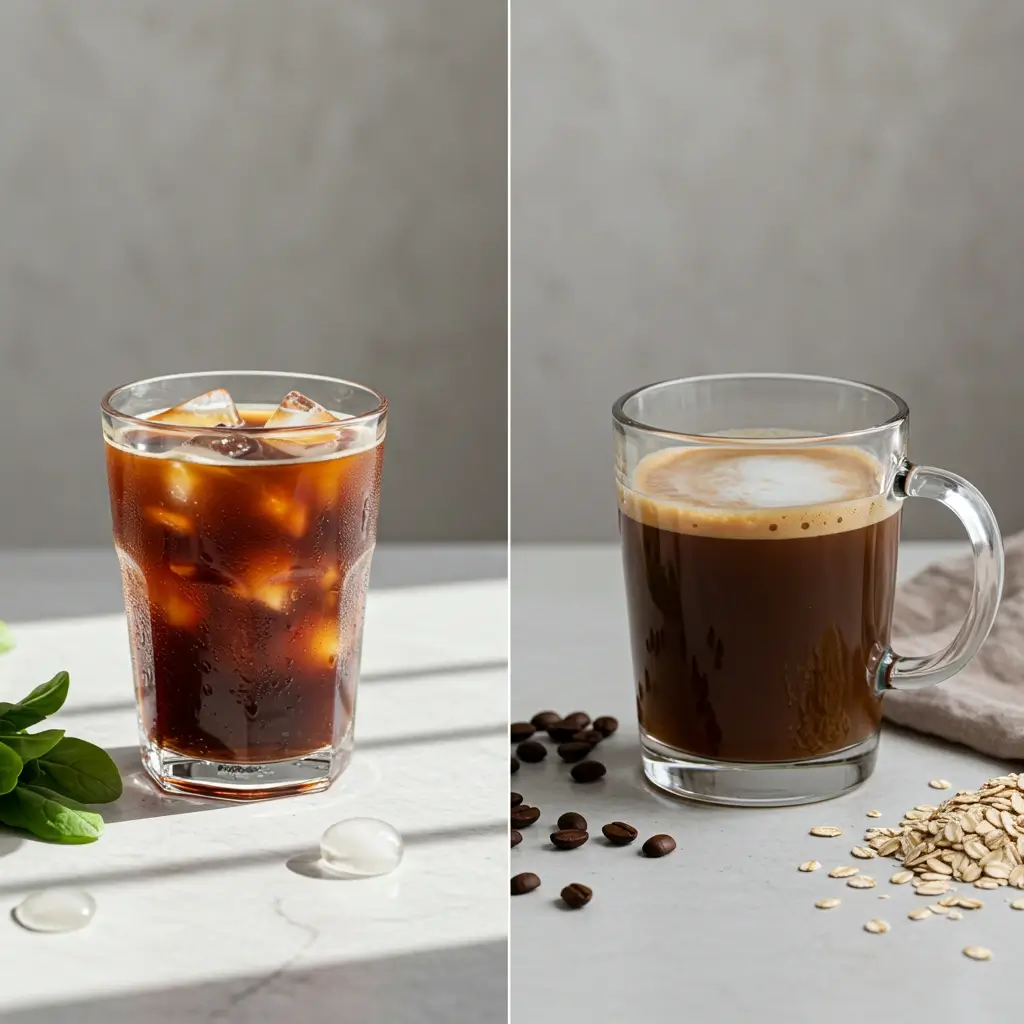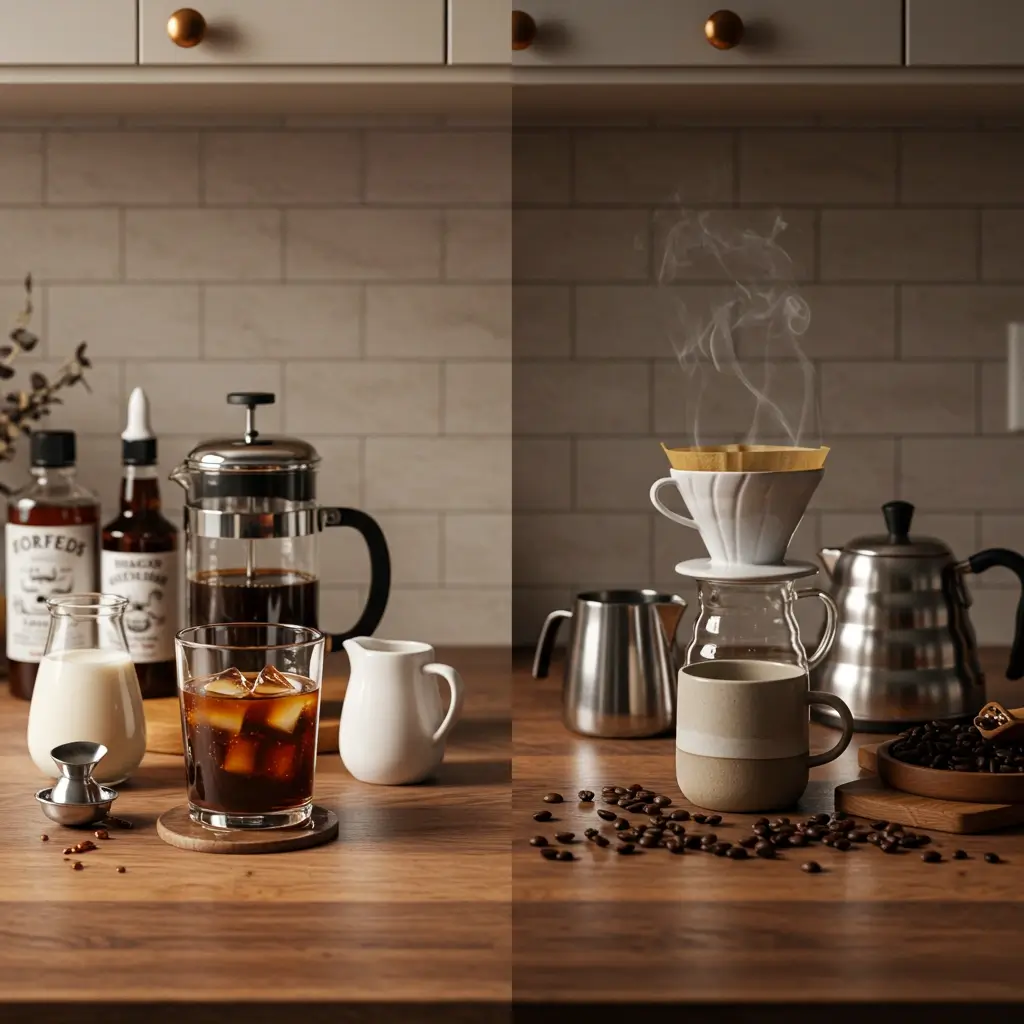INTRODUCTION:
Coffee is one of the world’s most beloved beverages, enjoyed in countless forms across cultures and climates. Among the most popular choices are iced coffee and hot coffee — but in the debate of Iced Coffee vs Hot Coffee, which one truly offers the best flavor, caffeine kick, and health benefits? Whether you’re craving a refreshing chilled sip on a hot day or a comforting warm brew in the morning, understanding the differences between these two coffee styles can help you choose your perfect cup.
In this comprehensive guide, we’ll explore how iced coffee and hot coffee differ in taste, caffeine content, and potential health effects. Plus, we’ll dive into tips on brewing the best versions of both to satisfy your daily coffee cravings. If you want to level up your coffee knowledge and enjoy every sip, keep reading!

1. Flavor differences between iced coffee and hot coffee
1.1 How temperature affects coffee flavor and aroma
The temperature at which coffee is brewed and served greatly impacts its flavor and aroma. Hot coffee releases more volatile compounds, giving it a stronger aroma and a richer, often more intense taste. In contrast, iced coffee tends to taste smoother and less bitter because the cold temperature numbs some of the acidity and astringency.
- Hot coffee offers a bold, aromatic experience.
- Iced coffee delivers a mellow, crisp profile with subtle sweetness.
- Cold temperatures can reduce the perception of bitterness and acidity.
These differences mean that your preference for either coffee style might depend on how much you enjoy bold flavors versus smooth refreshment.
1.2 The role of brewing method in flavor outcomes
Brewing methods affect both iced and hot coffee flavor, with popular options including drip, French press, pour-over, and cold brew. Cold brew, specifically designed for iced coffee, is brewed slowly with cold water and tends to be naturally sweeter and less acidic. Hot coffee methods extract different flavor compounds due to heat, resulting in more complex and nuanced profiles.
- Cold brew extraction produces smooth, chocolatey notes.
- Hot brewing methods often highlight bright, fruity, and floral tones.
- Using fresh, high-quality beans enhances flavor no matter the method.
Understanding these nuances helps coffee enthusiasts choose the right brew for their iced or hot coffee preferences.
1.3 Why iced coffee tastes less bitter and sweeter naturally
Iced coffee often has a naturally sweeter taste because the cold brewing process extracts fewer acidic compounds than hot brewing. Plus, chilling coffee dulls bitter notes and accentuates sweetness. This is why many people find iced coffee more approachable without needing much added sugar or cream.
- Cold brew iced coffee can be up to 67% less acidic than hot brewed coffee.
- Serving coffee over ice dilutes bitterness further.
- Natural sweetness can be enhanced by adding vanilla or caramel syrups.
For those seeking a low-acid, smooth coffee experience, iced coffee is a delicious and refreshing choice.
1.4 Aroma differences: hot coffee’s advantage
The smell of coffee plays a big role in flavor perception. Hot coffee releases aromatic oils and volatile compounds that evaporate quickly, creating a strong, inviting scent. Iced coffee’s aroma is more subtle because cold temperatures limit these volatile compounds from escaping.
- Hot coffee’s aroma enhances the overall drinking experience.
- Iced coffee’s fragrance is milder but can be boosted with spices or flavored syrups.
- Scent plays a psychological role in perceived taste and satisfaction.
Ultimately, your flavor preference may be influenced by how much you value aroma in your coffee enjoyment.

2. Comparing caffeine content in iced coffee and hot coffee
2.1 How brewing temperature influences caffeine extraction
Temperature and brewing time affect how much caffeine is extracted from coffee grounds. Hot brewing methods extract caffeine quickly due to heat accelerating the solubility of caffeine. Cold brew methods take longer but still extract high caffeine levels, often more concentrated due to longer steeping times.
- Hot brewed coffee typically has 95 mg of caffeine per 8 oz.
- Cold brew coffee can have 100-200 mg caffeine per 8 oz, depending on steeping.
- Iced coffee made by chilling hot coffee may have similar caffeine to hot coffee.
Knowing this helps you tailor your caffeine intake whether you want a quick boost or sustained energy.
2.2 Differences in caffeine between iced coffee and cold brew
While iced coffee is often just hot coffee poured over ice, cold brew is brewed slowly in cold water, resulting in different caffeine profiles. Cold brew tends to have higher caffeine concentration, but iced coffee caffeine varies based on the original hot coffee used.
- Cold brew caffeine content is generally higher and stronger.
- Iced coffee caffeine depends on the base hot coffee strength.
- Choose cold brew for a stronger caffeine punch; iced coffee for lighter caffeine.
2.3 How serving size impacts caffeine intake
Caffeine content scales with serving size. Many iced coffee servings at cafes are larger than typical hot coffee servings, which can increase total caffeine consumed. Additionally, added milk or cream can dilute caffeine concentration per sip.
- Standard hot coffee serving: 8-12 oz.
- Iced coffee servings often range from 12-24 oz.
- Pay attention to size when managing caffeine intake.
2.4 Tips to control caffeine intake with iced or hot coffee
If you want to manage caffeine without sacrificing flavor, consider:
- Opting for decaf or half-caff blends.
- Adjusting brewing strength or steeping time.
- Choosing smaller serving sizes.
- Adding milk or cream to dilute caffeine concentration.
By being mindful, you can enjoy your preferred coffee style without overdoing caffeine.

3. Health benefits and concerns of iced coffee versus hot coffee
3.1 Antioxidants and nutrients: similarities and differences
Both iced and hot coffee contain antioxidants like chlorogenic acid that help fight free radicals. Hot coffee’s antioxidants may be more bioavailable due to heat extraction, but cold brew retains many antioxidants as well.
- Coffee is a good source of antioxidants linked to lower risk of chronic diseases.
- Cold brew coffee may have slightly fewer antioxidants but is easier on the stomach.
- Both types can fit into a healthy diet when consumed moderately.
3.2 Impact on digestion and acidity
Hot coffee is acidic and can sometimes cause stomach irritation or acid reflux in sensitive individuals. Iced coffee, especially cold brew, is less acidic, making it gentler on digestion.
- Cold brew’s lower acidity reduces risk of heartburn.
- Hot coffee may increase gastric acid production.
- Those with sensitive stomachs often prefer iced or cold brew coffee.
3.3 Coffee and hydration: myths and facts
Coffee has mild diuretic effects but still contributes to daily hydration. Iced coffee can feel more hydrating due to the ice and cool temperature, making it a refreshing way to stay hydrated compared to hot coffee.
- Moderate coffee intake does not cause dehydration.
- Iced coffee may encourage higher fluid intake on warm days.
- Both are fine hydration sources within a balanced diet.
3.4 Potential health concerns with added sugars and creamers
Many iced and hot coffee drinks contain syrups, sugar, and high-fat creamers that add calories and reduce health benefits. Watching added ingredients is key to enjoying coffee healthily.
- Choose natural sweeteners or minimal syrups.
- Opt for low-fat or plant-based milk alternatives.
- Homemade recipes allow full control over ingredients.

4. How to make the best iced coffee and hot coffee at home
4.1 Essential equipment for brewing iced and hot coffee
To brew delicious coffee at home, having the right tools is key:
- Drip coffee maker or pour-over setup for hot coffee.
- Cold brew coffee maker or mason jar for cold brew iced coffee.
- Coffee grinder for fresh beans.
- Quality reusable ice cubes or coffee ice cubes.
These tools ensure consistent, fresh coffee any time.
4.2 Step-by-step iced coffee recipe for beginners
Here’s a simple way to make refreshing iced coffee quickly:
Ingredients:
- 1 cup freshly brewed hot coffee (stronger than usual)
- Ice cubes (regular or coffee ice cubes)
- Milk or creamer (optional)
- Sweetener (optional)
Instructions:
- Brew coffee using your favorite method, making it slightly stronger than normal.
- Let coffee cool slightly, then pour over a glass filled with ice cubes.
- Add milk or creamer to taste.
- Sweeten as desired, stir, and enjoy.
4.3 Quick hot coffee brewing tips for maximum flavor
For the perfect hot coffee:
- Use freshly ground beans.
- Maintain water temperature around 195–205°F (90–96°C).
- Brew for 4–5 minutes with French press or according to method.
- Serve immediately to preserve aroma.
4.4 Pro tips to customize your coffee experience
- Experiment with flavored syrups like vanilla, caramel, or hazelnut.
- Use cold foam or frothed milk to enhance iced coffee texture.
- Add a pinch of cinnamon or nutmeg for aroma boost.
- Try plant-based milks for different flavor profiles.

5. Trends and popular variations of iced and hot coffee
5.1 Popular iced coffee drinks around the world
Iced coffee has gained global popularity with many creative variations:
- Vietnamese iced coffee with sweetened condensed milk.
- Japanese iced coffee brewed directly over ice.
- Starbucks’ famous iced caramel macchiato and vanilla latte.
These drinks offer unique flavor twists inspired by local tastes.
5.2 Hot coffee favorites for different palates
Hot coffee remains a classic with varieties like:
- Espresso, Americano, and cappuccino.
- Seasonal favorites like pumpkin spice latte.
- Single-origin pour-overs highlighting bean terroir.
These options cater to diverse flavor lovers.
5.3 The rise of specialty coffee shops and home brewing
The specialty coffee trend fuels interest in quality iced and hot coffee. Consumers seek ethically sourced beans and craft brewing techniques both at cafes and home.
- Third-wave coffee shops focus on bean origin and brewing precision.
- Home baristas experiment with manual methods.
- Coffee subscriptions and fresh beans are increasingly popular.
5.4 How iced coffee is shaping summer coffee culture
Iced coffee’s refreshing nature makes it a summer staple. With innovations like nitro cold brew and coffee mocktails, iced coffee is expanding its appeal beyond traditional coffee lovers.
- Nitro cold brew offers creamy texture without milk.
- Coffee mocktails mix iced coffee with juices or spirits.
- Summer coffee festivals and events promote iced coffee culture.
CONCLUSION:
Choosing between iced coffee and hot coffee ultimately comes down to your personal flavor preferences, caffeine needs, and lifestyle choices. Iced coffee offers a smooth, refreshing taste with higher caffeine concentration in many cases, while hot coffee delivers complex aromas and quick energy. Both bring health benefits and unique drinking experiences that coffee lovers cherish.
Now that you know the flavor, caffeine, and health differences, you can confidently brew your perfect cup, hot or cold, at home. And remember, iced coffee isn’t just for summer — it’s a delicious, versatile beverage to enjoy year-round.
👉 Discover More Refreshing Iced Coffee Recipes to Try at Home



